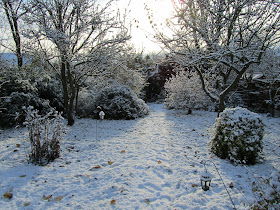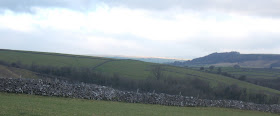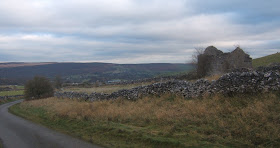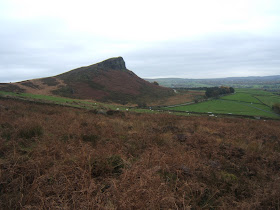It's funny how a spot of snow can turn even the most ordinary looking objects into somethng with the potential for being a Christmas card. Too late. I've written most of mine. Maybe next year - but for now, you'll just have to enjoy them on here.
Tuesday, 30 November 2010
Monday, 29 November 2010
An unexpected visitor
You know I said I had visitors. You remember! The ones who brought the snow! Well, actually, I had double visitors.
The snow-bringers were welcome and expected. The other visitor was also welcome, but definitely not expected. He wandered over my lawn at around 10am yesterday morning, much to the delight of both myself and Gill. I immediately grabbed my camera and started following his amblings.
Here he is!
It was freezing and he was just kind of pottering. I thought he should be tucked up all snug for his winter snooze by now, but my friend tells me that they sometimes wake to forage, so I looked it up on the British Hedgehog Preservation Society website, which says that a hedgehog may wake up several times and that, if you see one, you should just offer food and water and, if there are no apparent problems, leave it to go on its way.
This one looked fine, so I did just that (except that I became a bit of a shadow for a while).
He didn't seem at all bothered by my presence and was having a good old nose around, but I eventually left him in peace.
The snow-bringers were welcome and expected. The other visitor was also welcome, but definitely not expected. He wandered over my lawn at around 10am yesterday morning, much to the delight of both myself and Gill. I immediately grabbed my camera and started following his amblings.
Here he is!
Or, at least, there he went.
Look again...
HERE he is!
It was freezing and he was just kind of pottering. I thought he should be tucked up all snug for his winter snooze by now, but my friend tells me that they sometimes wake to forage, so I looked it up on the British Hedgehog Preservation Society website, which says that a hedgehog may wake up several times and that, if you see one, you should just offer food and water and, if there are no apparent problems, leave it to go on its way.
This one looked fine, so I did just that (except that I became a bit of a shadow for a while).
He didn't seem at all bothered by my presence and was having a good old nose around, but I eventually left him in peace.
I'll keep my eyes peeled for him though.
Sunday, 28 November 2010
Friday night and saturday morning
I've bought myself a new camera. I love my faithful old Fuji, but it's about seven years old now and has rather fallen behind the times with its 5 million pixels and 3x optical zoom. It takes good photos, but I've become increasingly frustrated with the shots I can't take; mainly because they're too far away. I wasn't intending to splash out quite yet, but I saw this deal and... well, you know!
It arrived on Wednesday morning, just in time for me to spend two frustrating days at work unable to try it out x-(
But then came the weekend and along with the weekend came visitors. I don't quite know how they did it, but before they arrived, the darkening world looked like this
and by the time they left, 18 hours later, it had changed to this...
...which is, apparently, the earliest snow for 17 years! I certainly don't remember having snow in November for a long time. It more usually hits us in January; that bleak, dark month which happens between the shining light of Christmas and the 'Thank you, God' of Spring, but here it is, so we'll wait to see how long it lasts.
Interestingly, Mark rang earlier to say that he's snowed in at a friend's house near Ullswater. They drove the 10 or so miles from Uni on friday night and now, they can't get back. Ooops!
It arrived on Wednesday morning, just in time for me to spend two frustrating days at work unable to try it out x-(
But then came the weekend and along with the weekend came visitors. I don't quite know how they did it, but before they arrived, the darkening world looked like this
and by the time they left, 18 hours later, it had changed to this...
...which is, apparently, the earliest snow for 17 years! I certainly don't remember having snow in November for a long time. It more usually hits us in January; that bleak, dark month which happens between the shining light of Christmas and the 'Thank you, God' of Spring, but here it is, so we'll wait to see how long it lasts.
Interestingly, Mark rang earlier to say that he's snowed in at a friend's house near Ullswater. They drove the 10 or so miles from Uni on friday night and now, they can't get back. Ooops!
Saturday, 27 November 2010
Quarries and farming
,
Derbyshire is the largest quarrying area in the UK. In the 1990s, it produced 20 million tonnes of stone each year, most of which was limestone. It's amazing the kind of stuff stone is used for. Did you know that, as well as the obvious building uses, stone (of various forms) is used in such things as toothpaste, cosmetics, soap, paint, fertiliser... (The list goes on.)
People often moan about the quarries, saying that they spoil the countryside but, for me, the quarry was part of my growing up. I remember that my cousin, when he was a student, worked for a while in the local quarry. He would come home at the end of each shift, covered from top to toe in grey lime dust. When I stayed with my 'Nanna on the Hill' and Grandad, the warning siren used to sound to signal the beginning of blasting at that same quarry. Wagons full of stone would trundle through the country lanes at regular intervals, many owned and driven by local men. Plus, for many years, my 'Nanna with the Hat' was a cook in the canteen there, even after that grandad was killed in an accident while setting the explosives for blasting out the rock. The quarry was part of everyday life in the village and everyone accepted it as such.
Although it may be true that quarries can be an eyesore, they are part of the lifeblood of the rural community, bringing work and money into the area. At the end of the day, the locals can't live on fresh air; there has to be work of some kind and a quarry is a good deal better than a lot of the alternatives!
Two of the major industries in rural Derbyshire are quarrying and farming.
People often moan about the quarries, saying that they spoil the countryside but, for me, the quarry was part of my growing up. I remember that my cousin, when he was a student, worked for a while in the local quarry. He would come home at the end of each shift, covered from top to toe in grey lime dust. When I stayed with my 'Nanna on the Hill' and Grandad, the warning siren used to sound to signal the beginning of blasting at that same quarry. Wagons full of stone would trundle through the country lanes at regular intervals, many owned and driven by local men. Plus, for many years, my 'Nanna with the Hat' was a cook in the canteen there, even after that grandad was killed in an accident while setting the explosives for blasting out the rock. The quarry was part of everyday life in the village and everyone accepted it as such.
Although it may be true that quarries can be an eyesore, they are part of the lifeblood of the rural community, bringing work and money into the area. At the end of the day, the locals can't live on fresh air; there has to be work of some kind and a quarry is a good deal better than a lot of the alternatives!
Farming, of course, is what everyone pictures when talking about the countryside, and it is true that there is plenty of that about too; though not so much as there used to be. In the Peak District, the main types of farming are dairy, beef and sheep; the altitude being a little high for arable crops which need the deeper soils of the lowlands. I love to see the fields, divided up by lines of drystone walls and dotted with cows or sheep. Beautiful.
Friday, 26 November 2010
Above Stoney Middleton
Just along the valley from Calver is Stoney Middleton. We drove up the steep hill past the tiny primary school (one of the smallest in Derbyshire with less than 30 children spread between the ages of 5 and 11) and onto the tops.
The views were spectacular and the sense of space, liberating.
It was so very Derbyshire; dry stone walls, a tumbledown barn, fields, sheep, woodland and edges - rolling hills with moorland. Wonderful!
Thursday, 25 November 2010
The Eyre Arms, Calver
Yesterday, I ate lunch with my family at this pub in Calver Sough, Derbyshire. It's a popular place, nestling under the towering gritstone heights of Froggatt and Calver Edges.
The pub is named after the Eyre family, who originally came to Britain with William the Conqueror in 1066 and, by the time Edward I came to the throne in 1239, had settled in the small village of Hope, north Derbyshire.
By medieval times, the family were Lords of a number of manors in Derbyshire and in Tudor England they held catholic enclaves at Hassop, Hope, Chesterfield and Hathersage. It was the Eyre family who were responsible for the building of St Michael & All Angels at Hathersage, after Sir Robert returned from the battle of Agincourt around 1381, and his house, North Lees Hall was the inspiration for Charlotte Bronte's Thornfield in the novel Jane Eyre.
During Elizabethan times, an Eyre was even High Sheriff of Derbyshire.
But it is at Hassop, three miles south of Calver, where the Eyres are most remembered, especially in the magnificent Hassop Hall, now a high quality hotel and restaurant, I have eaten there once, on a very special occasion, but today, we were happy to be at the pub.
Wednesday, 24 November 2010
The Roaches
The Roaches is a gritstone escarpment, situated in the Staffordshire Moorlands and rising to a height of 1,657 feet. The name comes from the French les roches, meaning the rocks, and the ridge marks the south-western edge of the Dark Peak area of the Peak District National Park.
The whole ridge, along with other gritstone formations across the Peak, is the result of prehistoric river deltas which laid down sand and grit over the limestone sea bed. Eventually, these became covered over with mud and coal and then compressed over millions of years to form the harder gritstone rock. With the moving of the tectonic plates, England was pushed up out of this sea and erosion did the rest, leaving exposed edges and outcrops of the harder millstone grit.
At the end of The Roaches, separated by a col, is Hen Cloud, which rises steeply above the surrounding land, making a particularly dramatic statement and revealing the layering from when the first rocks were formed, around 300 million years ago.
The Roaches provide some of the best gritstone climbing in the country, which explains why, during reading week, eldest son Mark and a group of fellow climbers came all of the way here from Cumbria; though I did splutter down the phone a bit when he told me that, having just gone all the way up to the Lakes for uni, he was trekking back to home turf to climb!
Besides, it gave him the opportunity to spend a couple of days at home after they'd done :)
At The Roaches stayed in Rock Cottage, a tiny house built originally as a gamekeeper's home and now converted into a climbing hut, owned by the British Mountaineering Council. It is just visible behind Mark, up through the trees on the edge of the photo.
And, looking the other way, is Tittesworth Reservoir, constructed between 1959 and 1963, to supply water for Leek and Stoke on Trent.
.
Incidentally, if anyone has a few spare millions lying around, The Roaches are up for sale. Currently the whole Roaches Estate is owned by the Peak National Park, but it is not normal practice for Park Authorities to own land, so they are looking for a buyer. It'd just better be someone who wants to care for the area, not exploit it!
Tuesday, 23 November 2010
Cooling Towers
From one ex-industrial site to another...
Once upon a time, those cooling towers were accompanied by chimneys and all of the other infrastructure associated with a fully functional coal fired power station. This location was an obvious choice. Water was in ready supply from the River Trent and the nearby Nottinghamshire and Derbyshire coal field would provide the coal. The bulldozers moved in in 1954 and preparation began on the land between the B5009 and the Derby to Birmingham railway line. The first unit of the A station was commissioned on 17th December 1957 and the station was officially opened on 2nd October 1959 by the 11th Duke of Devonshire.
During the 1980s, there was a series of open days, which were extremely popular. I regret that I didn't ever go for a look.
Privatisation in 1989, was the beginning of the end, with the first unit closing in January 1993 and the final unit seeing decommissioning on 31st March 1999.
Demolition of the site began in November 1999, until all that was left were the five cooling towers. And, 11 years later, still they stand, 300 feet high,with a diameter of 145’at their tops and 218’ at the base.
Monday, 22 November 2010
A friendly face and a series of small shocks
If you hadn't already guessed, I was at Magna for a Dr Who convention 'Time War 2010', staged in support of the BBC Children in Need Appeal.
All of the Dalek's from yesterday's photographs are home builds; none are BBC produced. Enthusiasts spend significant amounts of time constructing full size working Daleks. Most are powered by wheelchair motors (or similar) and have working dome lights, eye stalks and light-up lazer guns. It is quite a surreal experience to hold open a door for a passing Dalek!
I was at Magna with a couple of friends who are in the process of building their own Daleks and they had a table to display some of their part-build stuff in the exhibition room. Alongside their bits of Dalek, sat this...
It was amazing to see the number of children who would enter the exhibition room, spot K9 and run over to greet him; smiles broad from ear to ear! He was definitely a favourite! This K9 was built by Sacristan in the early 80s and is about 2/3 the size of the screen version. Except when he is on an outing, he lives in my friend's living room.
The table next door to us, held this...
All of the Dalek's from yesterday's photographs are home builds; none are BBC produced. Enthusiasts spend significant amounts of time constructing full size working Daleks. Most are powered by wheelchair motors (or similar) and have working dome lights, eye stalks and light-up lazer guns. It is quite a surreal experience to hold open a door for a passing Dalek!
I was at Magna with a couple of friends who are in the process of building their own Daleks and they had a table to display some of their part-build stuff in the exhibition room. Alongside their bits of Dalek, sat this...
It was amazing to see the number of children who would enter the exhibition room, spot K9 and run over to greet him; smiles broad from ear to ear! He was definitely a favourite! This K9 was built by Sacristan in the early 80s and is about 2/3 the size of the screen version. Except when he is on an outing, he lives in my friend's living room.
The table next door to us, held this...
Although only part built, this Dalek was beautifully crafted and had the added bonus of a remote controlled dome and eye stalk. I had a highly amusing hour or so watching a whole series of people examining this apparently inanimate object, only to jump in shock when it suddenly moved! One child physically leapt back around 18" when the eye stalk he was staring up at suddenly began to lower and stare back! I have to add that, once they had figured out what was happening, all of the surprised people were fascinated by the remote control and quite a number even had a go.
Sunday, 21 November 2010
Exterminate
Elsewhere within the walls of Magna, trouble was brewing. Alien forces were quietly amassing, bent on planetary domination.
Daleks from the Genesis, partnered with their new generation brethren who took on the might of the 9th and 10th Doctors, gathering, united in a common cause.
"Daleks are supreme! You will obey!"
Led by the infamous Dalek Storm!
But wait!
Help is at hand!
Where there is a TARDIS...
Saturday, 20 November 2010
The Gallery of Fire
Inside Magna, the huge galleries, which once roared with the sound and heat of the steel smelting process, are now quiet reminders of what once was. When I was a child, Sheffield steel was famous across the globe and I turned over many a piece of cutlery to discover the inscription 'Made in Sheffield'. Nowadays, it is more likely to read 'Made in China' or maybe 'IKEA'!
The enormous smelting buckets remain
and the red lighting gives a feel of the glow of the fires, which would have raged hot enough to liquify metal.
I liked this wrought ironwork, fashioned to represent flames in front of the anvil
and this kerosene burning column of flame always features on Magna advertising. I have to admit that it was rather impressive; a twisting, curling column of burning hot flame; like a small tornado of fire.
It seemed almost alive.
Friday, 19 November 2010
Magna
Located on Sheffield Road, just inside the boundary of Rotherham, Yorkshire, Magna Science Adventure Centre is a converted steel works.
Occupying an area a third of a mile long, the huge galleries incorporate four pavilions focussing on the elements of Air, Earth, Fire and Water. Within the Fire gallery multimedia shows play, telling the story of the steel smelting process, which was once the economic and social lifeblood of this community.
A stroll round the outside of the building quickly reveals the workings of heavy industry, from the small railed wagons,
to the enormous storage tanks
to the massive coal chutes, bridging high overhead
and the heavy duty crane gantries to lift and shift massive weights.
The sheer scale of the place was awe inspiring.
Thursday, 18 November 2010
Inquisitive
What is it with animals? They always seem so nosey; desperate to take a closer look - find out...
"Who's she?"
"What's going on?"
"Where did she come from?"
"What's she doing here?
"What's she up to?"
What has she got in her pockets?
AH ...
STOP RIGHT THERE ! !
'NUFF SAID ! !
While he's nibbling on what's come out of my pockets, why don't you go and feast on the other intriguing 'I' posts over at Jenny Matlock's Alphabe-Thursday.



















































